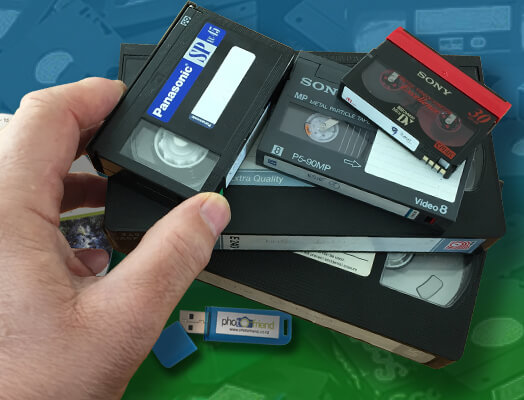Before video film and digital technology there was the film reel. Many people have these stored away and don’t realise that they may be deteriorating. They potentially hold precious family footage with links to family heritage. Maybe they even contain valuable information about local or national history.
The history of 8mm and Super 8 film
Standard 8mm film (recognisable by the square sprocket holes) was developed to be cheaper and more portable than previous film types. One of the problems was that it had to be reversed in subdued light half way through filming, and then the film would need to be edited to erase the bright light caused by the reversal.
In order to avoid this, Super 8 film was released in the 1960s (recognisable by the smaller, rectangular sprocket holes). These were extremely popular for the amateur in the late 60s and 70s. The Super 8 cassettes were easier to use than the old method of having to thread the film into the camera. Film reels were mostly replaced by videotape in the 80s.
Originally the films were silent but in 1973 a sound version was released. Therefore, some regular 8mm and Super 8 film will be silent and some will have sound. We only transfer sound from Super 8 films. The way to recognise film with sound is an orange magnetic strip which runs along the opposite side to the sprockets.
Film deterioration
It was once thought that film was timeless and indestructable. However, in recent years it is becoming apparent that this is not the case. Ageing tape may crack, curl or ripple, and this is a sure sign that the film is deteriorating.
Some films, which have mainly been kept in sealed canisters and not allowed to breathe, develop ‘vinegar syndrome’, so called because of the noticable vinegar smell when the canister is opened. Cleaning and digitising is the only sure way to save the footage, but in some cases it is already too late.
Conversion projectors
The old method of converting film reels is with a film projector which projects the film onto a wall or screen or projection box. The image is the captured on a video camera. This can cause problems with speed irregularities, focus and flickering, and, if using an older projector, can even damage the film if the projector is worn or dirty.
By far the best method, and the method we use here at Photofriend, is a frame by frame scanner. This is recent technology and results in capturing more detail, therefore creating a clearer picture. During the editing stage we can stabilise the footage and enhance brightness, contrast, colour and sharpness.
The Photofriend Studio
At Photofriend all the films are cleaned prior to transfer, and the transfers are done with high quality HD equipment at maximum resolution. The editing is done with industry standard video editing software. We take the utmost care with your precious footage.
We are a New Zealand family owned and operated business and all the work is done in our video and film studio. We receive orders from all over New Zealand. Turnaround time depend on our workload but is usually 1 – 2 weeks. If you’re interested please make an enquiry, use the online order form, or give us a call and talk to a friendly human!



 The audio cassette tape, or compact cassette, was first introduced in the 1960s. They were a popular method of home recording and listening to music albums until 2001 when CDs were introduced.
The audio cassette tape, or compact cassette, was first introduced in the 1960s. They were a popular method of home recording and listening to music albums until 2001 when CDs were introduced.
 Do you have old home videos from 15 – 30 years ago safely stored away? Maybe a precious wedding video, baby’s first days, the kids growing up, a 21st birthday, an anniversary, or irreplaceable footage of your grandparents? Can’t watch them because you no longer have a VCR? Are you happy that they are being stored in the correct conditions? Would you like to watch them again on your TV, computer or digital device? It’s not too late…
Do you have old home videos from 15 – 30 years ago safely stored away? Maybe a precious wedding video, baby’s first days, the kids growing up, a 21st birthday, an anniversary, or irreplaceable footage of your grandparents? Can’t watch them because you no longer have a VCR? Are you happy that they are being stored in the correct conditions? Would you like to watch them again on your TV, computer or digital device? It’s not too late… In this informative post we will be sharing some facts about why it may be time to transfer your old VHS, and other home videos, to either a DVD or USB device.
In this informative post we will be sharing some facts about why it may be time to transfer your old VHS, and other home videos, to either a DVD or USB device.
You must be logged in to post a comment.